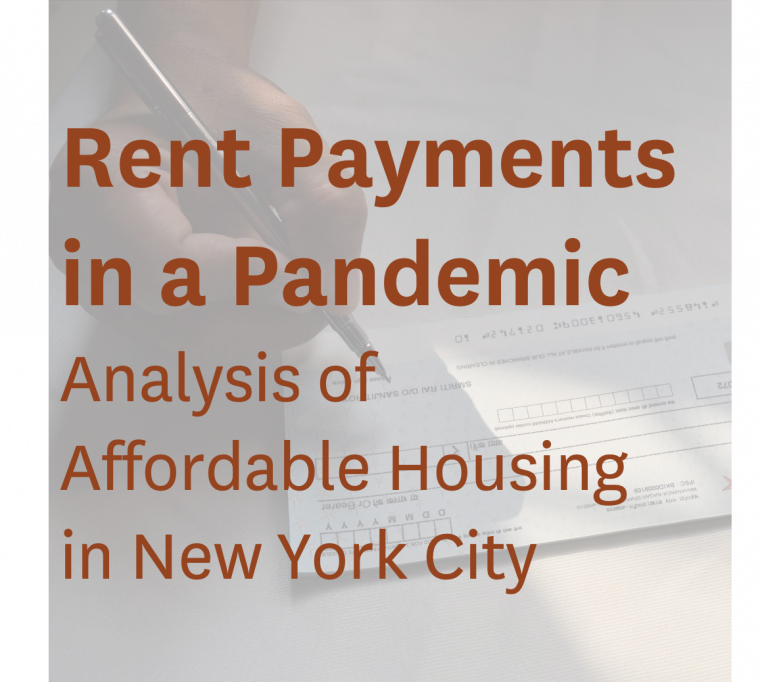
Rent Payments in a Pandemic: Analysis of Affordable Housing in New York City

One of the most pressing housing policy questions in the wake of COVID-19 is how rent payment rates changed during the pandemic. Rent debt is a leading indicator of housing instability, which many fear could surge once eviction moratoria expire. Further, rent payment rates have a profound effect on the owners, lenders, and housing quality. Rental income funds capital repairs, improvements, and debt service costs, meaning a sustained and substantial dip in rental income could have systemic effects on the entire ecosystem connected to housing. In a new report, we analyzed rental payments from over 18,500 primarily below-market rate units from New York City to understand how renters’ payment rates and rental arrears evolved during the COVID-19 pandemic. The brief finds decreasing payment rates and an increasing share of households with rental debt after March 2020. Households in the sample with rental arrears saw an average increase of 43 percent in the rent they owed. Disturbingly, the data also shows that New Yorkers struggling with rent payments before the pandemic started saw the largest increases in rental debt.
The research, done in partnership with the New York State Association for Affordable Housing (NYSAFAH) and the Housing Crisis Research Collaborative, offers valuable insights into actual rent payments and the accumulation of rental arrears at the household level before and after the pandemic began in March of 2020.
The sample used by the authors–with data ranging from January 2019 to September 2020–provides a view into a subset of New York City housing that includes below-market-rate rental units often made affordable through various programs, such as Low Income Housing Tax Credits (LIHTC) or Section 8.
-
What happened to rent payments and arrears?
- Across the sample, rent payment rates were lower in 2020 than in 2019, resulting in a larger accumulation of rental arrears in 2020. On average, households in the sample paid rent at lower rates in 2020, resulting in an increase in the total amount owed by tenants. The analysis found that between March and September of 2020, average monthly payment rates were 95 percent, down from 98 percent over the same period for 2019. Decreased rent payments are problematic for landlords’ ability to cover costs and result in accumulating rent debt for tenant households.
- Throughout 2019 and 2020, close to half of the tenants in the sample were in rental arrears. While many households entered 2020 with arrears, that share increased after the crisis began. The share of households owning rent was 52 percent in September of 2019 and rose to 55 percent one year later.
- Between September 2019 and September 2020, the average rental arrears for tenants that owed rent increased by 43 percent. Not only did the share of households with arrears grow, so did the average amount of arrears. The analysis showed an increase from $2,009 to $2,871 between September 2019 and 2020.
-
Who was most -- and least --- able to pay their rent?
- Payment rates were consistently higher and declined less after March 2020 for tenant households with subsidies than for those without. Households with affordable housing subsidies that adjust with changes in income (such as Section 8) did better during the crisis than their counterparts in the study. Households with subsidies had higher and more stable payment rates than those without the support of those programs.
- On average, households that were more than one month behind on their rent at the end of 2019 paid a lower share of their rent in 2020 than households who were not. Households already struggling before the crisis showed lower payment rates than the rest of the sample between April and September 2020. They were also less likely to be subsidized (44%) than the overall sample (56%).
-
Which households accumulated more rental arrears?
- Between September 2019 and September 2020, the number of tenant households in severe rental arrears more than doubled. The research found that the number of households in the sample who owed more than $10,000 in rent arrears increased by 108 percent—the rent owed by these tenants also rose from 35 to 50 percent of all rent owed.
- Average rental arrears increased more among unsubsidized households, and the number of unsubsidized households in extreme rental arrears increased by 127 percent between September 2019 and 2020. Average rent owed by unsubsidized households rose by 49 percent between September 2019 and 2020, compared to 37 percent for their subsidized counterparts. In addition, the number of subsidized households owing more than $10,000 increased by 87 percent, while the number of unsubsidized households in severe rental arrears increased by 127 over the same period.
- Average rent arrears for households who started 2020 more than a month behind in rent increased from $3,805 in September 2019 to $5,981 in September 2020. Households with a higher rental debt level (more than one month behind) at the end of 2019 saw their average arrears increase by 57 percent between September 2019 and September 2020.
While the findings are not representative of all New York City rental housing, this sample provided critical insights around rent payments and rental arrears during the pandemic. Notably, it showed that rental payment rates decreased, which increased the amount of rent debt for households in the sample. By September 2020, rental arrears for households that owed $10,000 represented 50 percent of the total rent owed. However, households with subsidies that adjusted according to changes in income had higher and less variable payment rates during the crisis.
Further research will expand the sample beyond September 2020. In addition, it will seek to understand additional aspects affecting rent payment and arrears, including exploring building and program characteristics, changes in landlord behavior, and vacancies.


